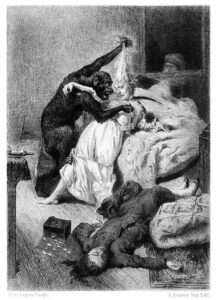
Edgar Allan Poe (born 1809 – died 1849) is best known for his poetry and tales of supernatural horror. Who among us hasn’t read poem “The Raven” or encountered a classic horror stories like the “The Tell-Tale Heart” or “The Fall of the House of Usher”? But Poe’s influence was felt far beyond poetry and gothic horror. With “The Murders in the Rue Morgue,” he created an entirely new literary genre – the detective story – introducing the world to what are now common elements of detective fiction – a brilliant, eccentric detective and his admiring sidekick; murder victims discovered in a locked room; the arrest of the wrong person; and an ingenious solution to a seemingly impossible crime.
Despite the popularity of “The Murders in the Rue Morgue,” Poe wrote just two more detective stories (“The Mystery of Marie Roget,” and “The Purloined Letter”) before his death. But these, and the characters Poe created, inspired many others, including the most famous of all detectives– Sherlock Holmes. Arthur Conan Doyle acknowledged this debt in his first Sherlock Holmes novel, A Study in Scarlet (1888), when Watson says Holmes “remind(s) me of Edgar Allen Poe’s Dupin.” While Poe has been a continuing source of inspiration to writers of poetry, horror and the supernatural, these genres have many other sources. In contrast, all detective stories and police procedurals have Edgar Allan Poe’s C. Auguste Dupin as their source, and this digital edition is designed to introduce the general public to Poe’s first detective story and its influence on all detection fiction that followed.
Annotation of “The Murders in the Rue Morgue”:
Additional Resources:
Analysis: